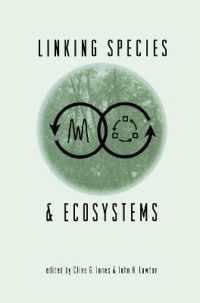- ホーム
- > 洋書
- > 英文書
- > History / World
基本説明
It was the intensified interaction between culture and power-politics that created what we now call 'the Baroque'. Based on a rich variety of, hitherto largely unexplored, primary sources, the book addresses the basic issues of papal power in the post-Tridentine period.
Full Description
In ten chapters, partly case-studies, this monograph analyzes the (new) ways in which cultural manifestations were used to create the necessary preconditions for (religious) policy and power in the Rome of Urban VIII (1623-1644). It was the intensified interaction between culture and power-politics that created what we now call 'the Baroque'. Based on a rich variety of, hitherto largely unexplored, primary sources, the book addresses the basic issues of papal power in the post-Tridentine period. It does not study actual papal politics, but rather the cultural forms that were essential to the representation and legitimatization of the papacy's power, both secular and religious and that (co-)determined the effectiviness of papal policy. Precisely during Urban's long pontificate, the manifold, always imaginative and often unexpected uses of power representation became, in the end, not so much a series of cultural forms as, in a sense, the structure of early modern (Roman) society.
Contents
Foreword
Acknowledgements
Introduction. When the bees flew...
Prologue. Giacinto Gigli, chronicler, or: power in the streets of Rome
1. The Barberini build a chapel, or: rising to power in post-Tridentine Rome
2. Maffeo Barberini - Urban VIII, the Poet-Pope, or: the power of poetic propaganda
3. The 'Days and Works' of Francesco, Cardinal Barberini, or: how to be a powerful cardinal-padrone?
4. Prince Eckembergh comes to dinner, or: power through culinary ceremony
5. The Bare Feet of St Augustine, or: the power of religious images
6. Lucas Holste (1596-1661), scholar and librarian, or: the power of books and libraries
7. Ibrahim al-Hakilani (1605-1664), or: the power of scholarship and publishing
8. Urban VIII between White Magic and Black Magic, or: holy and unholy power
Epilogue. The Return of the Muses: instruments of cultural policy in Barberini Rome, 1623-1644
Conclusion. "l'Età fortunata del Mele", or 'Honey's Happy Age': the Barberini pontificate as a generation, a crossroads—problems of perspective
Index








